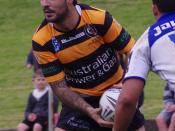Wade vs. United StatesIn 1967, the U.S. Supreme Court heard the case of Wade vs. U.S. to determine whether courtroom identifications of an accused at trial are to be excluded from evidence because the accused was exhibited to the witnesses before trial at a post-indictment lineup conducted for identification purposes without notice to and in the absence of the accused's appointed counsel.
On September 21, 1964, The federally insured bank in Eustace, Texas, was robbed by a man with a small strip of tape on each side of his face he entered the bank and pointed a pistol at the female cashier and vice president forcing them to put the bank's money into a pillow case. After receiving the money, the man drove away with an accomplice who had been waiting in a stolen car.
An indictment was returned against Wade and two others on March 23, 1965 for conspiring to rob the bank and also against Wade and the accomplice for the robbery.
Wade was arrested on April 2, and counsel was appointed to represent him on April 26. On April 17, an FBI agent arranged to have the two bank employees observe a lineup made up of Wade and five or six other prisoners without any notice to Wade's lawyer. Each person in the line wore strips of tape on their face and said words uttered by the robber.
After hearing each one in the lineup, both employees identified Wade as the robber. At the trial, both employees pointed directly at Wade when being asked if the robber was in the courtroom. During cross examination, both employees brought forth the prior identification lineup which gave Wade's counsel the chance to move for a judgment of acquittal or the striking of the bank employees identifications due to the fact...


